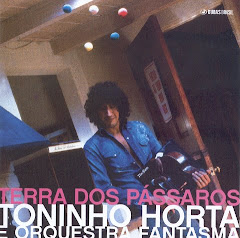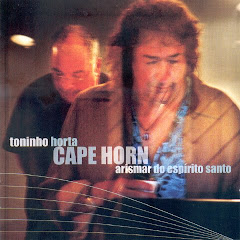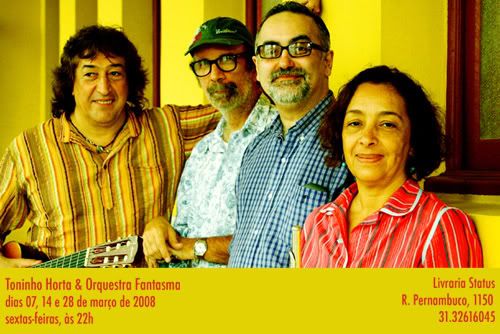October 27, 2008
Bossa Still Sounds Nova Fifty Year Later
Tim Wilkins, a frequent contributor to these pages and editor of the jazz.com Encyclopedia of Jazz Musicians, reports on a celebration of bossa nova featuring (among others) the fine Brazilian guitarist Toninho Horta, who deserves to be much better known by jazz fans. His account is below. Check back here soon for Wilkins’s follow-up review of Brazilian music in performance (next time: Milton Nascimento). T.G.
Pianist Cliff Korman calls the Manhattan School of Music an "innovatory", rather than a conservatory, and on Tuesday night I could hear why. A noncommercial island in New York's musical stream, it has some of the city's best players as students and faculty, who consistently perform miracles.
The concert on Tuesday (October 21) was one such miracle. The school brought guitarist Toninho Horta from Brazil to celebrate "50 Years of Bossa Nova". The concert, which spanned nearly three hours, evoked the future of Brazilian music as well as its past. The event was the brainchild of Korman, a Long Island native who spends half his time in Rio, soaking up the city's samba, choro and gafiera, when he is not teaching at MSM. The concert was subtitled "To Jobim with Love" to honor Antonio Carlos Jobim, the composer who hatched the laid-back jazz hybrid in Rio in the late fifties.
Pat Metheny calls Toninho Horta "the Herbie Hancock of the guitar", and rightly so. He is a master of inner voicings with a lyrical style which feels at home in any musical setting. But he is not from Rio—he’s from Belo Horizonte in Minas Gerais, an inland city ringed by mountains, far from the sand and sea celebrated by Jobim. Yet like many of us, he remains drawn to bossa nova's rebellious calm. "Everybody wanted to play like that—ting ting, ting ting", he recalled with a smile about the first time he heard bossa nova at age ten. "Very simple, but very cool".
By thirteen, Horta was writing songs, and at nineteen he was winning prizes alongside another Minas native, singer Milton Nascimento. The pair inspired a movement in Belo Horizonte called "clube da esquina”—the "club on the corner"—which offered a more open alternative to Rio's studied cool and the surrealistic ironies of the Tropicália musicians from Bahia and Sao Paulo.
"I never really set out to be a jazz musician", says Horta, whose early influences included Debussy, Tatum, Mancini and Kenton. His seemingly effortless musical range led to close collaborations with a who's who of Brazilian musicians, including Elis Regina, Chico Buarque, and Sergio Mendes. When he moved to the U.S. in the eighties, he worked with Metheny, Wayne Shorter and Bobby McFerrin, among others.
Horta's music involves more colors than the original bossa, which he draws from the baroque church and Pink Floyd, by way of Ellington and Tatum. Like Tatum, his harmonic flights always sound like an organic outgrowth from the composition.
"Those aren't the changes I learned in Long Island!" Korman joked onstage after Toninho led the band through his reharmonization of Jobim's classic "Once I Loved". Korman’s point was twofold: not only does Horta depart from the original versions, but the bossa nova songs which entered the jazz repertoire during the genre's brief boom in the U.S. at times lacked the harmonic, and rhythmic, subtleties of the originals.

Pat Metheny calls Toninho Horta "the Herbie Hancock of the guitar", and rightly so. He is a master of inner voicings with a lyrical style which feels at home in any musical setting. But he is not from Rio—he’s from Belo Horizonte in Minas Gerais, an inland city ringed by mountains, far from the sand and sea celebrated by Jobim. Yet like many of us, he remains drawn to bossa nova's rebellious calm. "Everybody wanted to play like that—ting ting, ting ting", he recalled with a smile about the first time he heard bossa nova at age ten. "Very simple, but very cool".
By thirteen, Horta was writing songs, and at nineteen he was winning prizes alongside another Minas native, singer Milton Nascimento. The pair inspired a movement in Belo Horizonte called "clube da esquina”—the "club on the corner"—which offered a more open alternative to Rio's studied cool and the surrealistic ironies of the Tropicália musicians from Bahia and Sao Paulo.
"I never really set out to be a jazz musician", says Horta, whose early influences included Debussy, Tatum, Mancini and Kenton. His seemingly effortless musical range led to close collaborations with a who's who of Brazilian musicians, including Elis Regina, Chico Buarque, and Sergio Mendes. When he moved to the U.S. in the eighties, he worked with Metheny, Wayne Shorter and Bobby McFerrin, among others.
Horta's music involves more colors than the original bossa, which he draws from the baroque church and Pink Floyd, by way of Ellington and Tatum. Like Tatum, his harmonic flights always sound like an organic outgrowth from the composition.
"Those aren't the changes I learned in Long Island!" Korman joked onstage after Toninho led the band through his reharmonization of Jobim's classic "Once I Loved". Korman’s point was twofold: not only does Horta depart from the original versions, but the bossa nova songs which entered the jazz repertoire during the genre's brief boom in the U.S. at times lacked the harmonic, and rhythmic, subtleties of the originals.

Bossa Nova at MSM (photo by Brian Hatton)
Bossa Nova was first a revolution of rhythm, then of dynamics: João Gilberto found a way to condense the patterns of Rio's raucous samba schools on the six strings of his quiet guitar. To this, Antonio Carlos Jobim added impressionistic harmonies drawn from jazz, but the foundation of bossa was always rhythm. This point was sometimes lost to Americans, who identify the genre more with the affectless delivery of Astrud Gilberto's English vocals on "The Girl from Ipanema" with Stan Getz from 1964.
Korman's reworking of "Ipanema" was one of the evening's highlights. Taking his cue from Horta, he led the band through a moody, wide-open reharmonization of the tune which highlighted bossa nova's untapped possibilities, more than its nostalgia for sand and sea. "Just open your ears, and drop this necessity of identifying one thing to represent a culture that's immense", Korman said. "I hope that I'm opening some creative windows to say we can really do something with this music".
The concert was really three programs in one: first, conductor Justin DiCioccio led the the school's jazz orchestra through a set of elegant Jobim arrangements commissioned by members of the Westchester Jazz Orchestra. These included Scott Reeves' "Waters of March", Mark Patterson's "Agua de Beber" and Tony Kadleck's "Desafinado". Rather than count off the the band, DiCioccio rubbed his hands together to simulate the sound of feet shuffling through sand, setting up the deceptively simple pulse essential to bossa nova. To further emphasize the importance of this "foreign" rhythmic sensibility, on "Agua de Beber" the band set down their horns to follow him through a spokenese arrangement of vocal polyrhythms.
Second, Toninho led the band through versions of some of his best-known compositions, including "Moonstone",
"Broken Kiss", "Aqui, Oh!" and "From Ton to Tom", which can be heard on his album To Jobim With Love, released by Resonance Records in September.
Third, Korman led the rhythm section through a set of "samba-jazz", Brazil's take on hard bop, which thrived alongside bossa nova but is little known in the U.S. This included his arrangements of "Ipanema" and "Embalo", by pianist Tenorio Jr., as well Horta's "Bons Amigos" and
"Aquelas Coisas Todas". It was during this third "set" that the rhythm section really caught fire, with drummer Will Clark catching a groove with Horta, percussionist Café da Silva and bassist Billy Clark.
Other standout soloists were trombonist Timothy Vaughan, who brought fearless swagger to "Desafinado", without turning the song into salsa stomp. Jay Rattman offered a beautifully understated baritone sax solo on the evening's opener, "Look to the Sky", which made it clear that he understands bossa's quiet fire. Saxophonist Steve Wilson, also on the MSM faculty, also joined the band at Horta's request and contributed fine solo work to "From Ton to Tom" and "Comecar de Novo".
Throughout, Korman, Horta, and Café pushed and pulled the beat with bossa nova's subtle sixteenth-note accents, capturing the revolutionary equipoise of Gilberto, Jobim and the other originators of the style. The evening was a testament to the enduring possibilities of bossa nova, which suggests that the conversation between the musics of the United States and Brazil, two bulwarks of African culture in the New World, has just begun.
"We're celebrating the great reach of two musics that meet, and create", Korman told the audience. "Two musics which really meet as equals, and celebrate each other; that's what we're celebrating tonight".
Korman's reworking of "Ipanema" was one of the evening's highlights. Taking his cue from Horta, he led the band through a moody, wide-open reharmonization of the tune which highlighted bossa nova's untapped possibilities, more than its nostalgia for sand and sea. "Just open your ears, and drop this necessity of identifying one thing to represent a culture that's immense", Korman said. "I hope that I'm opening some creative windows to say we can really do something with this music".
The concert was really three programs in one: first, conductor Justin DiCioccio led the the school's jazz orchestra through a set of elegant Jobim arrangements commissioned by members of the Westchester Jazz Orchestra. These included Scott Reeves' "Waters of March", Mark Patterson's "Agua de Beber" and Tony Kadleck's "Desafinado". Rather than count off the the band, DiCioccio rubbed his hands together to simulate the sound of feet shuffling through sand, setting up the deceptively simple pulse essential to bossa nova. To further emphasize the importance of this "foreign" rhythmic sensibility, on "Agua de Beber" the band set down their horns to follow him through a spokenese arrangement of vocal polyrhythms.
Second, Toninho led the band through versions of some of his best-known compositions, including "Moonstone",
"Broken Kiss", "Aqui, Oh!" and "From Ton to Tom", which can be heard on his album To Jobim With Love, released by Resonance Records in September.
Third, Korman led the rhythm section through a set of "samba-jazz", Brazil's take on hard bop, which thrived alongside bossa nova but is little known in the U.S. This included his arrangements of "Ipanema" and "Embalo", by pianist Tenorio Jr., as well Horta's "Bons Amigos" and
"Aquelas Coisas Todas". It was during this third "set" that the rhythm section really caught fire, with drummer Will Clark catching a groove with Horta, percussionist Café da Silva and bassist Billy Clark.
Other standout soloists were trombonist Timothy Vaughan, who brought fearless swagger to "Desafinado", without turning the song into salsa stomp. Jay Rattman offered a beautifully understated baritone sax solo on the evening's opener, "Look to the Sky", which made it clear that he understands bossa's quiet fire. Saxophonist Steve Wilson, also on the MSM faculty, also joined the band at Horta's request and contributed fine solo work to "From Ton to Tom" and "Comecar de Novo".
Throughout, Korman, Horta, and Café pushed and pulled the beat with bossa nova's subtle sixteenth-note accents, capturing the revolutionary equipoise of Gilberto, Jobim and the other originators of the style. The evening was a testament to the enduring possibilities of bossa nova, which suggests that the conversation between the musics of the United States and Brazil, two bulwarks of African culture in the New World, has just begun.
"We're celebrating the great reach of two musics that meet, and create", Korman told the audience. "Two musics which really meet as equals, and celebrate each other; that's what we're celebrating tonight".
This blog entry posted by Tim Wilkins
.







































Nenhum comentário:
Postar um comentário